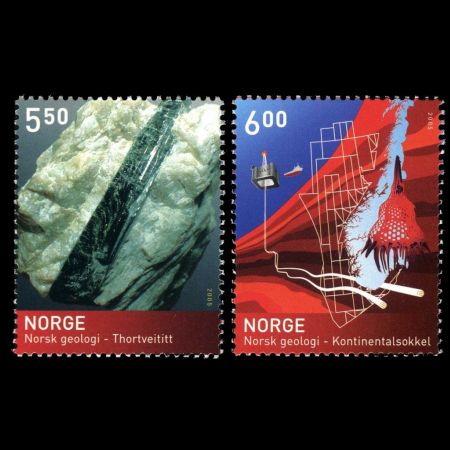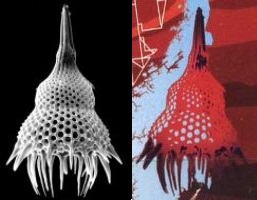Norway 2005 "Centenary of Geological Society of Norway"
| <prev | back to index | next> |
| Issue Date | 16.09.2005 |
| ID | Michel: 1552-1553; Scott: 1448-1449; Stanley Gibbons: 1580-1581; Yvert et Tellier: 1495-1496; Category: pF |
| Design | Ashley Booth |
| Stamps in set | 2 |
| Value | NOK 5.50 - Thortveitite (mineral) NOK 6.00 - Fossil radiolarian (Lamprocyclas maritalis), map of Norway and continental shelf, oil rig and ship, pipeline, and geological cross section. |
| Emission/Type | commemorative |
| Issue place | |
| Size (width x height) | 30 mm x 35 mm |
| Layout | Two Sheets of 50 stamps |
| Products | FDC x 1, PP x1 |
| Paper | |
| Perforation | 13.25 x 13.75 |
| Print Technique | Offset, multicolor |
| Printed by | Joh. Ensched, Netherlands |
| Quantity | 600.000 sets |
| Issuing Authority | Norway Post |

On September 16th, 2005, the Post office of Norway issues the set of two stamps "Centenary of Geological Society of Norway".
The following text is a quote from the Presentation Pack, produced by Norway's Post. Description of Radiolaria was added by the author of this website.
A time span of more than 4.000.000.000 years is not easy to grasp, but that
is how far back in time we have to go to trace the origin of our planet.
At that time, the earth was just a red-hot, molten mass.
This hardened in time, arranging itself in layers.
While the innermost core is solid and has a temperature of between 4.000 C and 7.000 C,
the next layer is still molten and red-hot.
Surrounding it is a thick mantle of heavy rock.
The outermost layer, the continental and oceanic crust, is a thin shell, 70 km thick at the most.
The distance to the centre of the earth is 6.371 km.
The prehistoric era (pre-Cambrian) lasted from about 4.500 million to about
545 million years before our time.
Rock species from that time are spread over various land areas and geologists
believe these were once part of one large continent which was split and later spread.
At the beginning of the Cambrian Period, the sea covered part of Norway.
The coastline ran past Gjvik, Hamar and Trysil and the land was covered in ice.
In the course of a few million years, Greenland
became separated from Norway.
However, the process did not stop there.
In the Devonian period, which started about 417 million years ago, Norway and Greenland
were reunited as part of one continent.
During the subsequent Carboniferous period, huge primeval and swamp forests came into
being in what was later (when Norway and Greenland had parted company again) to become the North Sea.
The primeval forest was virtually impenetrable.
At times it was flooded and sand and mud were washed down from the surrounding land,
burying and hermetically sealing the organic material.
Today, this material is extracted in the form of oil and gas.
One of the stamp subjects, taken from the Continental Shelf, shows the
connection between geology and oil and gas recovery.
The other shows the world's first scandium mineral, Thortveitite.
It was discovered in Setesdal in 1903 and called after Norwegian mineral
exporter Olaus Thortveit (1872-1917).
The stamp with the Continental Shelf showing a fossil radiolarian, Lamprocyclas maritalis.
 |
| Lamprocyclas maritalis - photomicrograph versus representation on the stamp |
Fossil radiolarians have been found that date to Precambrian Time (3.96 billion to 540 million years ago).
Lamprocyclas maritalis:
Shell campanulate in form and fenestration, but not so slender and with different peristome. Cephalis subspherical, with a very stout, pyramidal horn of twice the length, the edges of which are spirally convoluted. Outer coronal of the peristome with twelve to fifteen short, divergent feet, inner with as many convergent, longer feet.
Products and associated philatelic items
| FDC | Examples of circulated cover | Presentation Pack |
 |
 |
|
| Philatelic Souvenirs | ||
| Presentation Pack | Souvenir Folder | Presentation Sheet (A4 size) |
 |
 |
 |

|
References
- Technical details and stamps presentation:
Presentation Pack, colnect -
Radiolaria:
Wikipedia, Encyclopedia Bbritannica.- Lamprocyclas maritalis:
radiolaria.org, mikrotax.org, University of Hawaii System,
- Lamprocyclas maritalis:
Acknowledgements
Many thanks to Dr. Peter Voice from Department of Geological and Environmental Sciences, Western Michigan University, for reviewing the draft page and his very valuable comments.| <prev | back to index | next> |